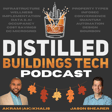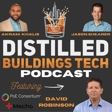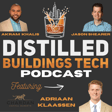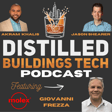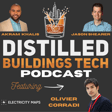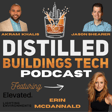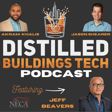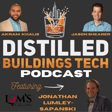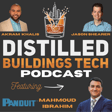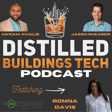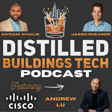Introduction to Hosts and Guest
00:00:20
Speaker
Welcome everybody to the Distilled Buildings Technology Podcast. Where smart buildings are stirred, shaken, and data-driven. I'm your host, Jason Scheer. i your host, AK.
00:00:30
Speaker
And today we're ah here with ah Scott Panzer.
Scott Panzer's Career Journey
00:00:33
Speaker
So Scott, welcome to the show. Thank you for having me. Yeah, awesome. So, AK and I know you pretty well. I've gotten to know you really well over the past couple of years. But for those of us those of our audience out there that have never had the the chance to to spend time with you, Scott, like tell us a little bit about your background and like how you got to where you are today with with DBS and and JLL.
00:00:57
Speaker
So, if you want to go back to Conception, we can stay there and have some fun. Born in Brooklyn, well, I guess Conception is somewhere so near there. born Born in Brooklyn, winged in Queens, puberty in in a suburb of of New York City.
00:01:12
Speaker
um Off to University of Miami at the ripe old age of 17, thinking I was going to be Jacques Cousteau II. So um spent four years in ah marine science and biology and chemistry.
00:01:26
Speaker
um No grants for doing research at
Founding of Digital Building Solutions
00:01:28
Speaker
the time. So I said, let me try dental school. ah p Applied to dental school, got in went to to the to yeah the clinic in NYU. and said, I don't think I want to look down people's throats the rest of my life. So went back to Miami, got my MBA, graduated from there, and then went into business.
00:01:45
Speaker
So started working at Reader's Digest and went over to doing mergers and acquisitions. for Robert Maxwell. And if you know the famed Ghislaine Maxwell, that's her father.
00:01:56
Speaker
So we spent several years doing M&A, took over all the real estate, launched a lot of projects with him.
What is Digital Building Solutions?
00:02:02
Speaker
Then they filed bankruptcy. I started my consulting company doing the work out of the real estate.
00:02:07
Speaker
And then for the last 34 years, I've been doing commercial real estate. And then eight years ago, On a lark, we started digital building solutions with the with really being a cutting edge in terms of what offices need, what buildings need to be intelligent going forward.
00:02:23
Speaker
That's awesome. is it Scott, just give a brief description of what what DBS does and what services does it provide today? So Digital Building Solutions, aka DBS, is is an end-to-end solution for occupiers, developers, owners who are looking for um intelligent systems to be part of their narrative.
00:02:46
Speaker
on on whether they're going to build a new building retrofit their office space um going forward it's 21st century going to 20 cents 22nd century technology the technology continues to grow and expand and and do what it needs to do um no different than if you're looking at at electric cars or you're looking at self-driving vehicles like WAMO. I mean, it's the same sort of thing.
00:03:09
Speaker
So DBS takes the end user customer from conception and consulting to the end deliverable and then does it manage service um after that.
Technology and Spirits
00:03:20
Speaker
Awesome. um and And I know just from our experience together, it's ah it's a pretty <unk> pretty disruptive process to the to the status quo, which I'm sure we'll talk a lot about today. But before we do, um you know part of the Still Buildings Tech podcast is kind of bringing together spirits and, and, and technology in the building space. So we always have our guests, you know, share with us, like what is what's, what's in their glass today.
00:03:46
Speaker
So normally, and as I was, we talked about earlier, normally my, in my glass would have been a nice martini shaken, not stirred. um But considering that I flew up from Palm beach to my house in Connecticut and I'm sitting there going, it's 42. I left 90 degree weather to come to 42 degree weather.
00:04:03
Speaker
My ah in my glass today, is a little bit of bullet. Excellent. the One big rock. So that's it. There you go. Cheers, guys. Cheers. here's yeahp There it is. Oh, you're going to send me one of those glasses now, right?
00:04:17
Speaker
Oh, yeah. We'll bring one to New York for you. Totally. bring it to Cisco Live. Yeah. Yes. Yeah. We'll bring it out there. And and the the the combination of bourbon and a rock, Scott, is it one big rock? Is it a little bit of rock? Is it neat? but What's your... Mine is one big rock.
00:04:35
Speaker
Yep. Okay. It melts slow, stays cool, just enough, right? Because if you get normal, right just every time you drink a little bit, all the stuff goes in your face and you, you know, yeah this works out much better.
00:04:47
Speaker
Yeah. We had, we had a conversation, um, when we were up in New Jersey a couple of weeks ago, aka with, uh, um, with a bottle store owner in Maplewood, uh, around like the preference, right. And the style around that. And think for us, it always comes down to like drink, drink bourbon or drink whatever you want, like whatever style you want.
Evolution of Building Technology
00:05:07
Speaker
Um, yeah. Good stuff. Cool. Um, so, Disruptive technology in the building space. Talk a little bit about like, what is the, like, what's the business imperative around that, that technology led motion and why are customers looking at that today?
00:05:29
Speaker
So if you go back 20 years, let's go back 25 years. Everybody had a telephone telephony. Everybody had a telephone on their desk. And then they went to VoIP, right? Voice over IP.
00:05:43
Speaker
And now it doesn't exist anymore, right? We're doing it all on our on our on our computers. Similarly, you look at the technology in an office space environment or industrial space environment, and everything was incandescent lamps. Then it went to fluorescent lamps.
00:05:59
Speaker
um For industrial, the T8s, right? They went to halogens, right? They wanted something. But all each one of those... while there was a level of efficiency associated with the lamping, right?
00:06:10
Speaker
The next iteration was LED fixtures. And 15 years ago, nobody was jumping on LEDs. Why? Oh, they said we couldn't tune them. We couldn't balance them. We couldn't dim them. We couldn't do all these things.
00:06:22
Speaker
And yet today there's not a single new installation that is not available. totally permeated with all LED fixtures. The lighting designers will still turn around and say, no, let me have an inconsistent warm kind of thing.
00:06:35
Speaker
But at the same time, LEDs 100% there all the time. At the same time, controls of those fixtures became much more important going forward. So you had companies like Wattstopper and Lutron and others step in and say, well, we'll give you a more robust control package.
00:06:53
Speaker
So what what we've done and in our environment, just taking the the lighting piece for the moment, is we've said, wait a second, why do you have to have two different systems? Why do you have to have a line voltage system, which is inefficient because you're stepping it down to a low voltage to meet the needs of the LED board?
00:07:11
Speaker
And then you have to have a separate wiring or non-wiring for the control side. We said, okay, isn't there something out there that can do the same? And sure enough, Cisco and others, but not as much as Cisco, but others came out with this switch technology said, hey, I'll give you power out of a port and I'll also let you have data transmission on that port.
00:07:31
Speaker
And then we had companies that came out and said, wait a second, like MHT inspector or Molex and others said, wait a second, we'll give you the control piece and also turn the lights on and off and do all the other things. And we can now communicate with shades and now we can communicate with VAV control boxes and now we can do waypoints and we can do all these other things that that you didn't have before.
00:07:52
Speaker
So the disruptor around this is the fact that under one category cable, right, we can push enough power and grab all the data in one piece, which then when you look at what's happening and what Cisco's has done with spaces and others, you're now saying, wait a second, I can grab all that environmental data and have one dashboard that takes it out of there. So everybody's jumping on that now.
00:08:13
Speaker
Everybody wants it, but here's what's the the interesting thing, as I think you alluded to earlier. There's a little bit of pushback in the industry, but it's very, very selfish pushback.
00:08:24
Speaker
So selfish from the standpoint of an EC, electrical contractor, doesn't understand, wait a second, I'm going to lose the ability to run the voltage, that light now.
00:08:35
Speaker
Don't worry about we'll handle that. We'll figure that out. We'll show you how you still make money. We're an MEP mechanical electrical plumbing engineer says, wait a second, I'm going to lose money on how I design that lighting package. We'll say, no, no, we're going to teach you how to do that.
00:08:48
Speaker
We're going to show you how to do that. So you can then do that, still capture the
Overcoming Resistance to New Technologies
00:08:51
Speaker
same revenue you would have for your client. But now you're giving them a much more robust, interactive, intuitive system that they didn't have before. So we have that pushback, but then we're showing them how to step over that.
00:09:03
Speaker
And how are you changing that? You know, you have a unique lens, right? You come from the broker side and the real estate commercial real estate, and then you have you have a servicing and development of a customer relation, giving them that opportunity to see from a technology standpoint, this is the way to design your new building.
00:09:20
Speaker
How do you bridge those two together? and And what does that mean to the client? So, but well, I'll tell you it means is the client. It's sort of like the guy sitting in the room that, like me,
00:09:32
Speaker
Right. That doesn't have an Hispanic name or Hispanic look, but speak Spanish fluently. And everybody else around them is Hispanic. And they're talking think, I don't know what they're saying. Well, the reality is when you go into an industry like that, I'm coming from the lens of, of my JLL BC hat.
00:09:48
Speaker
right, where I understand the real estate world, i understand the construction world, I understand how they think, I understand from project management all the way down to delivery. And we're sitting and going, guys, you're all talking around each other, and you're all taking advantage of a client and trying to push your narrative forward for the financial benefit of yourself, not necessarily for the client.
00:10:05
Speaker
I went, wait a second, by the way, you know, guys, I understand Spanish, you can't hide that from me. Let's have that language now. And they go, well, we didn't know he knew that. So all of a sudden people are standing up and going, okay, we got to, we got to deal with this, right?
00:10:18
Speaker
We'll have to figure out what it means. So what we're spending a lot of time doing is leveling out CapEx pricing, right? Where we get pushback. um And we're showing the end user customer that, that what they're being told is not correct.
00:10:31
Speaker
false narrative, false news. Here's the reality. You'll say it's equal to or less on CapEx. We have all the data to show it and we'll have energy savings going forward.
00:10:43
Speaker
that's That's really interesting. We had we had a conversation with ah Jeff Beavers, with Nika a couple a couple of weeks ago, and he highlighted just some of the challenges in the electrical trade as as a whole of like lower lower labor capabilities. right like There's some somewhere around like in the 10,000 electricians leaving the trade and only seven thousand coming in which When you think about supply and demand, that's just going to push lead times and project schedules out because those high voltage electrical contractors just don't have the the capacity.
00:11:19
Speaker
does that Does that come into the the equation when you're talking to owners, reps and and MEP firms? Not necessarily. I can see where it might in the future, but um robotics and more importantly,
00:11:37
Speaker
the advent of um simpler tools are making the speed to delivery for electricians, plumbers, HVAC mechanics a lot quicker.
00:11:49
Speaker
But I will tell you that um if I had a young son or daughter today um i in their teens and they were thinking about what do they want to do with their life,
00:12:00
Speaker
I'd say go into the trades because you'll be you'll be the most sought after person out there out of all your friends. In the future, i'm mark my words, you can put it you heard it on this bot podcast and I've said it on other podcasts, AI is going to make a lot of humanity superfluous.
00:12:18
Speaker
A lot of programmers are going to go away. a lot of technicians are going go away. What's going to be out there that net is needed. You're still going to have to have that hand-eye coordination, but you're not going to be sweating pipes anymore.
00:12:30
Speaker
You've got, you're going to be crimping them. The electrical side of it, you still have to run that piece of it, but the low voltage side is so much easier and so much safer. And that's, and that's the, that's the, so they're going to have to reinvent themselves. Now what they'll do is it's no different than what, what, what bumblebee tuna fish did with the can of tuna fish.
00:12:47
Speaker
It used to be a dollar 40, And you got 1.4 ounces. Now it's $1.70 and you're getting one ounce, right? So what electricians are going to do is, I guess I used to run conduit. I used to run the BX or the, I used to run the Romex inside that conduit. used to run BX.
00:13:00
Speaker
I'm now going to run the low voltage cable, but I'm still going to charge you $180 an hour, right? Where, right where The low voltage guy today is only charging at $70 an hour. So that's where the inherent savings comes today. There's going to be a merge of those two. There's going to be a crossover.
Integrating Real Estate, Construction, and Technology
00:13:14
Speaker
And at that apex in the next five to seven years, you'll see that happening.
00:13:18
Speaker
The other thing that's going to happen, I think, is that that the unions are deathly afraid of low voltage. Why? Because it's safe. What they hang their hat on is why you need unions of saying, we're going to deliver safe solutions.
00:13:31
Speaker
Well, you don't need safe and low voltage. You could take a category... Think of a category cable, RJ45, stick it on your tongue. You won't feel that. Not even like a nine volt battery. If anybody's ever seen that, you do that for with a socket.
00:13:45
Speaker
yeah what Right. no ah so i so there's There's a lot of that happening in the industry. Yeah, that's, that's a good point. and And really topical, like my oldest son graduated high school this week. And I'm really grateful that he's not going into a software development or computer science, you know, course of study.
00:14:03
Speaker
um He's not going into the trades, but he is just kind of sticking to like a general, you know, business and marketing track, which I think i think you people are people people ah people people's skills will always be, will always be king.
00:14:15
Speaker
For sure. For sure. Yeah. and And you mentioned a few things, Scott, when you and you say that you know the industry might be a little bit worried and afraid. And how do you bridge that the two with not introducing scarcity, but just allowing them to think through the innovation?
00:14:31
Speaker
This is no different to what you said. Voice over IP was not around, and then it became around, and now it it's gone. And all of a sudden, we had a BlackBerry, and we we were afraid to touch a screen, and we can't live without a phone that has touch base.
00:14:45
Speaker
how do you but yeah How do you bring that forward to to the trades to say, look, this is not going to take your job. You might just need to adapt. And what's the best way to actually do it? So what we've done is in a city like New York, which is heavily unionized, we've gone to the elect league the local three electoral unions and look, guys, here, play in the sandbox.
00:15:05
Speaker
Because if you don't, you're going to lose 100%. So capture 50 to 60%. It'll scale back over time, but you're still the net winner. What does that mean? Well, you still have an electrical fixture, so you can claim that as your jurisdiction.
00:15:17
Speaker
You got to hang the electrical fixture. You'll take delivery of it. They'll hang it. I mean, just to give you an example, like if if you buy any and anybody who's done this before, you know, the cost to manufacture a typical two by two troffer fixture is about $35 to $40.
00:15:31
Speaker
By the time it shows up and installed on a job, whether it's office or industrial, it's over $350. It's insane. Huh? Jeez, you just gave out MHT lighting pricing. Right.
00:15:47
Speaker
It doesn't mean that you buy it for that price. No, it doesn't mean you buy it because here's what happened. You go through distribution, you distribution, then you get the markup and the markup and the markup. But the point is that is that by the time it shows up on site, it's tenfold what it originally started at from a manufacturer. right So what happens is you say that you say to everybody, we're going to make it more efficient.
00:16:06
Speaker
And I think that that some of the things that in the programs that we're doing, when we talk about even, and I'm a big guy, look, I coined the phrase hunt as a pack and everybody's jumping on it now, is that we go to each of these people and we say, here's what you're going to get.
00:16:18
Speaker
This is what you're going to keep as your part of it. We go to the MEP consultant, right? The E side of the MEP, the electrical. And we say, take your low voltage people. We're going to teach them how to do a proper drawing around a low voltage distributed infrastructure using power over ethernet.
00:16:33
Speaker
Once they get, once they perfect that and they master that, they'll capture that revenue. Right. So, so DBS is acting as, as both an educator and an integrator for the industry.
00:16:45
Speaker
and And what's happening is you're getting greater adoption as we go through that. The more people that get to see what the, the economic benefit is to them, the more that will continue to grow what they want to do with it.
00:16:55
Speaker
Yeah. one and and you You brought up that point around you know like the MEP organizations and and and specifiers. We hear a lot from like project managers that like risk, right that they're really they're afraid of this technology because they think it will incorporate risk into their project, derail timelines, all of that.
00:17:17
Speaker
like how do we How do we generally like work around that or convince them that this is going to not risk your product or your project, but rather like de-risk your project.
00:17:28
Speaker
So first you have, so, we you know, look, we've got, we've got four and a half million square feet of successes, right? Having done this work, but we also have, um, about,
00:17:39
Speaker
not as many, but probably um let's say 10 projects that didn't go well for project managers, didn't go well for um construction managers, didn't go well for electrical contractors.
00:17:52
Speaker
Why? Predominantly because it was poorly poorly designed by people who professed to say they can do it, right? And then they somebody took that poor design and did a poor installation.
00:18:04
Speaker
And yet, yet it's so much simpler than, than doing line voltage and having controls. So there's a little bit of that that goes in. Um, there's a little bit, Hey, I don't want to really change and and depart from what I've done for the last 125 years. Think about this line voltage AC has been around for 125 plus
Intelligent Buildings and Data Utilization
00:18:24
Speaker
So they don't want to change that. They went to school for that. The old guard's still doing that. The new guard's coming in and doing it. They're paying they're This will go out there and I'm sure I'll get spanked for it by somebody.
00:18:35
Speaker
But everybody's got a lot of stuff going on under the table between a project manager, the construction manager, and the subcontractors. There's a whole lot of things changing hands. I'm not saying it's necessarily money, but there's a whole lot of things that are changing hands at making that that ecosystem that you're constantly kind of breaking through on.
00:18:51
Speaker
The PMs are saying, we don't want to touch it because we've had some failed projects. Why? Well, as I said, bad design, bad and ah execution. We've come in and fixed the bad execution and we're unwinding some of the bad design.
00:19:04
Speaker
So part of it is education. It's knowledge transfer. And once people get comfortable with it, they'll jump into it. Not everybody gets in a race. Everybody drives a car. Anybody who's 17 or older in this country drives a car.
00:19:16
Speaker
Not everybody will get on a racetrack. But if you teach somebody how to do that, they'll do it. Not everybody's buying an electric car. Not everybody wants a thousand gigawatts under their, you know, what's, but that's why.
00:19:27
Speaker
But ultimately that may be the full adoption if you go forward with that. So there's lots of things that are happening. The mob will move and sway depending upon where the wind goes and that and how much wind goes into that sail.
00:19:40
Speaker
Speaking of, I think, well, first of all, congratulations on trademarking Hunters the Pack. I think that was a smart one. I've heard it. Did you see it? I wasn't sure you saw it yet. Yeah, it's out there. heard it heard it Heard it here first.
00:19:53
Speaker
Yeah, yeah. We hear people still still saying it over and over. So congratulations on that. But for the audience that's listening, that... they don't understand any of the nuances and it's great to know that. But if I'm a building owner and I just want to know what it's what's the day of life of just an intelligent building that Scott builds four and a half million square feet of, what does that look like?
00:20:14
Speaker
um Well, it looks like what we're doing right now on our computers. There's a dashboard. That dashboard gives you all real time data on what's happening.
00:20:26
Speaker
It's literally like going into your car and you turn the key or you push the button and all of a sudden, remember, you used to just have analog gauges. Now you have a center screen. That center screen is all touch point and that can tell you what what's going on.
00:20:40
Speaker
Cisco Spaces, which which um was was really an offsuit of of of a software that I started putting together and we showcased for a bunch of people, um now gives people real time, gives occupiers real time, gives building owners real time data for what's happening.
00:20:59
Speaker
and And that data is so critical. The next iteration that's happening is that's the if, that's the if then in the programming side. When you get to the second part of it, the go to, which just envisage for a moment walking into a conference room,
00:21:14
Speaker
that's fully integrated, right? Through low voltage distributed data transmission and power. What does that mean? Well, it counts the people that are in the room. It tells everybody what the temperature, tells everybody what the environment, tells everybody how many VOCs or O2 or CO2 levels in there. And an automat the AI side of it automatically adjusts that room.
00:21:36
Speaker
so So when you start talking to the end user, the customer, what are they getting? They're getting access to data and that data is going to ultimately drive what happens and the narrative and what happens for that that space going forward. that's That's what we're talking to them about.
00:21:52
Speaker
And it's really kind of like bridging the gaps between the the different data domains that have always been in silos, right? So like HVAC, they were locked up in their little bubble. Lighting was locked up in their bubble.
00:22:04
Speaker
um You know, the IT side, maybe a bigger bubble, but they were, they were somewhat isolated. So in a, in a building of the future and intelligent building, like all of those silos are either broken down or or connected and able to share data.
Smart Systems: Residential vs Commercial
00:22:20
Speaker
And what's funny is that, is that, is that the, the commercial real estate is so far behind residential. I'm sitting in my, I'm sitting in my, my house in Connecticut right now, right? I can sit there and say, Alexa, breakfast lights on.
00:22:37
Speaker
Right? Oh, everybody ever everybody everybody's Alexa's like on the ah the listening to the podcast. Exactly. Everybody's lights going you're right Alexa, your house is going, we don't have breakfast lights here. What are you talking about? It's going, wait, no, that's in my other place.
00:22:51
Speaker
Right? but it's funny. I got to be careful because if I say the wrong thing, I'll shut my lights off in my Palm Beach house. yeah And then so, right. So now, but think about that. And i can say, okay, Alexa, breakfast lights off.
00:23:03
Speaker
But when I came in um earlier, she didn't hear me. Alexa, breakfast lights off. so So when I came in the house, right? When I came in the house earlier, right?
00:23:14
Speaker
I said, Alexa, I'm Guess what? She knows I like the temperature at X. And if ah if I know I'm going to watch TV, the the TV will come on. How is it that we don't have that in commercial space?
00:23:28
Speaker
Now, let me give you more if even... Greater examples. You get on a plane. We all travel somewhere around the world. You get on that plane. You think the pilot's flying that plane.
00:23:40
Speaker
That pilot sits there and puts a whole bunch of digital inputs into this thing. Right. Puts all the vectoring around. He may put the throttles forward, keep his hand on or her, heart keep the handle on.
00:23:52
Speaker
That thing takes off. Once it gets to a certain point, they hit a button and the plane does the rest. And they're only there if all a sudden the computer shut down. um we've've I've heard that a lot from um a colleague of ours at Cisco. you know he he uses the metaphor of like self-driving cars, right? Yeah.
00:24:08
Speaker
self-driving cars and that industry has been a lot shorter, you know, comparatively to buildings, but we don't have self-driving driving buildings yet. and But We have the capability of doing it.
00:24:20
Speaker
And not that's that, but what's the harm? What's the harm in this? if If the self-driving building system fails and shuts down, you're still going to have a building engineer within X minutes to do that.
00:24:33
Speaker
And it's not like the building's just going to explode.
Early Adopters of Intelligent Building Tech
00:24:36
Speaker
We're talking about heat, air conditioning, lighting, shades, right? BMS. I mean, think about that. It's very...
00:24:46
Speaker
I was in California. I called a Waymo, right? The Waymo shows up. There's nobody in the front seat. It's got all these cameras, everything going in. I get in the backseat. I close the door. It was weird. It was like really strange.
00:24:58
Speaker
It was something at a total recall. Yeah. You know, what's the next iteration from that? I can't imagine. Someone's going to pop out of the glove box and they're going to give me a glass of bullet.
00:25:08
Speaker
That's next. That's next. Yeah.
00:25:12
Speaker
So get given your expertise in in DBS and and handing over projects, give us some success stories that that you've developed. And the customer went back and says, I want to do this again. And I want to do it around the globe.
00:25:25
Speaker
What that look like? So believe it or not, the the the major law firms were, I would say, the early adopters of this technology because they said you know what we need to think about our partners and and what makes their life better simpler faster um so that actually real quick that's that's really fascinating like that that vertical because they tend to be really conservative Like from a technology standpoint, financially conservative. So I'm really interesting to hear about like the the compelling why. so so yeah so
00:26:05
Speaker
you you know, Skadden, Arps, Migrant, Flom, one of the top firms in the in the world, were the first adopters of it. guy named Peter Lesser is head of IT t there. Really, really smart guy. i said, I want this.
00:26:16
Speaker
um And he was early, early adopter. i think he did his six years ago. um So was older technology. I believe they may be even under a 60 watt, not 90 watt platform when they did theirs.
00:26:28
Speaker
um But again, he had, he had some issues with it. He's still happy with it, had some issues with it, but it was based upon, again, poor design, poor execution. Following through, right. There's been five other major law firms that have all put it in.
00:26:43
Speaker
We did Sherman and Sterling end to end solution, not a single glitch with the whole project. Right. End to end. Debovoy and Plimpton, 600,000 square feet. They put it in. Actually, the the general contractor split the the execution up between us and another firm.
00:26:59
Speaker
The other firm's six floors were, I would say, not a fail, but maybe 70% success. We were a hundred percent success. We came in and fixed the other 30%. We're now doing day two managed service and support for Debevoie and Plimpton.
00:27:12
Speaker
So when you think through what happens, it's it's back to the narrative that we started with. It's simple. If you just understand what it is and take your time to do it, right? You don't get in the car and just drive and think I'm going to make it the first time somebody has to educate you.
Challenges in Adopting Intelligent Systems
00:27:27
Speaker
So the more we educate, the more we go through that, the adoption is going to continue to grow. has been a tremendous rollout for warehouse and distribution centers. Now, I think AK's own companies has picked up several million square feet of, of warehouse, um, for their product to go in because why it's simple to just plug an RJ 45 into the light and pull it out.
00:27:50
Speaker
Yep. Cookie cutter. we're We're having the same conversations around, yeah know, around data centers, obviously a data center boom, And even though, you know, 90% of the time it's lights out operation, they still need lights.
00:28:02
Speaker
That's exactly right. So, so putting in like, and and those, those, those deployments are so cookie cutter, right? Like every data center, you can, you can just template it out. And again, as we talked about it, this is not limited to lights. This is, this is oh yeah any, any, any power injected low voltage endpoint that wants data is under the same capacity.
00:28:23
Speaker
What are some of those endpoints that you're seeing, Scott, that the audience can hear and go, oh, I didn't even know that could be possible?
00:28:31
Speaker
Well, I mean, cameras for one. I mean, everybody's all about, you know, camera awareness, what's happening, right? What's going on in my space? um It's not so much that we're're that that companies want to check up on their employees, right? It's that they want to use that data to then drive, okay, what's my occupancy utilization?
00:28:53
Speaker
So that's something you wouldn't have thought about. The environmental endpoints. covid COVID gave us, you know, kind of a wake up, a little slap in the face and said, hey, we're a little bit carefree and cavalier about, you know, how we do things and and in our environment. So um and I think, you know, humans are pretty funny. they're It's sort of like ah humans are sort of like a beehive.
00:29:12
Speaker
you shake the nest, right? You, you poke at it and everybody swarms and goes crazy. And all of a sudden you leave it alone for a couple of minutes and it sort of settles back in. So humanity is sort of settling back in, right? From, from the 2020 to 2022 shutdown.
00:29:29
Speaker
yeah The interesting thing that, that we're now seeing is that, but people want to understand really what's going on now. we And then, you know that That, as you know, that kicked off this whole hybrid work model because technology ramped up to meet that that isolated yeah workforce.
00:29:45
Speaker
And they said, okay, but now everybody wants to sort of shuttle back in. Or they woke up and realized, despite the fact that I put it up big on my LinkedIn, because I'm really big at posting there' a lot of stuff on LinkedIn, as you guys know. oh yeah Controversial or not, right? I don't really care.
00:29:58
Speaker
right so So I said, everybody's getting back to the office. 2025 or 2026, everybody's back to the office. Why? One, because they want to... B two, because they want that knowledge transfer three, because guess what?
00:30:10
Speaker
You can't have an office romance side affair if you're not in the office. Right. So, and people miss that. Look, and even the new Pope that just came in, he will tell you that, yeah, that goes on in the office. It happens. Right. So, so, um, but but, but, but, but technology is going to be the facilitator, but whether it's from a health and wellness standpoint, or we have seen some of these instances of,
00:30:35
Speaker
You know, a company, you know, like, like on Monday morning saying five days a week back to the office, everybody comes in and then it's musical
Scaling Operations Globally
00:30:44
Speaker
chairs, right? Like no one has a place to work. They're not quite sure how they're supposed to interact.
00:30:48
Speaker
And technology has the potential to like help make that transition a little more smooth. A hundred percent. And Jason, so that, and that's why the occupancy utilization.
00:30:59
Speaker
So we used to do, we did a study for NBC universal, ah where they wanted to know wait where people are when they come in. And it's not a matter of just looking at badge swipes when you come and it's all like, they came in on this floor.
00:31:10
Speaker
Okay. Big deal. So they came in on that floor, but they could have gone down the stairs to three floors below. Where did they go when they went on that floor? Now we're not going to do GPS ID on your phone, but we're going to be doing people counting set. And we're going to look at desk counting.
00:31:24
Speaker
So when you have products like MHC Inspector has, we have this desk cradle hub now that can go into that and we say, hey I've got people doing keystrokes and and they're using a desk. But if there's if that desk is idle and and and we have 100 desks on a floor and 50 of them are idle, well, those people have to be somewhere.
00:31:43
Speaker
And if we can't track them hiding in the bathroom, but we can certainly track them if they're in a conference room or in their collaborative space, I guess eventually we'll track them in the bathroom, but not in cameras. We'll use something else for that.
00:31:54
Speaker
um Yeah. Infrared. Infrared. Infrared. Exactly. It's like that. Yeah. It's like the scope. Yeah. Well, and and that's that. I think that's like.
00:32:05
Speaker
That's probably the problem that a lot of people are thinking through is can I make my building smart when I'm starting with, with an existing space versus new concrete and steel? Like, is that, is that possible to like retro technology into a space? Sure. So, so Goldman Sachs owns the Conrad hotel in New York.
00:32:29
Speaker
They came and said, we want to do a renovation, but we need to do it in inside of eight weeks. And we want it to be intelligent. We want to have all the cabling infrastructure in place so that we can meet the growing componentry that's going to come out over the next five or seven years.
00:32:45
Speaker
We said, sure, we could do that. And we did in eight weeks, two summers ago, they did a gut of the ceiling. nothing else, go to the ceiling, move some walls around, brought all new LED low voltage efficiency light fixtures.
00:32:59
Speaker
Everything was overpowered and we left a whole bunch of spaghetti up in the ceiling for them to grab endpoints for sensor technology going forward. It's as simple as that. When I think when actually you guys did it, when Cisco, Cisco took their brand new space, Paris, France, right off of the Champs Elysees in an old building, but was modernized infrastructure.
00:33:25
Speaker
It was delivered by the landlord or the owner of the building with an in already installed. Warm ceiling, meaning it had lights, it had shades, it had a bunch of stuff with Schneider electric in there.
00:33:38
Speaker
We said, no, it's not so intelligent. we're going to make it smarter. We took one floor and we showcased how we could use the existing fixtures that were there. just recable it with power ethernet, bring all that smart technology and then bring all the end point end points that Cisco has as part of Cisco spaces on that second floor.
00:33:56
Speaker
Everybody was like, Oh, you could do this anywhere. We could do it anywhere in the world. Wow. So, so a lot of, a lot of fixtures are capable of just like replacing the driver from a line voltage driver to a POE driver in a minute, in a minute.
00:34:10
Speaker
Yeah. and And you're doing this, Scott, you mentioned Paris and you mentioned global. How how are you doing this at scale? I mean, yes, you are in Connecticut and Palm Beach at the same time. so we How do you do it globally?
00:34:22
Speaker
So there's two there's two there's two ways to scale. one Well, there's three ways to sell, actually. actually Scaling is all about making sure you have the right people, technology, and and and workforce, right, as part of that whole people person thing in in a location.
00:34:40
Speaker
So you can go ahead and build it. mean, I can go hire people. in each in market internationally, or I can go ahead and buy a company that's already there.
Enhancing Energy Efficiency with Solar and Microgrids
00:34:52
Speaker
Or the third way is create what the Japanese are so so good at, which is the kiritzu and do that kiritzu where we partner with a very strong firm. So for example, we came and, and, uh, we brought in a team called out of India called Sigma bite.
00:35:10
Speaker
Sigma bites, one of the largest low voltage installers integrators in all of India, solid people, trust the people. and We really did a lot of interviewing and and negotiating back and forth about what they had, what we had understanding, really learning about each other.
00:35:27
Speaker
Got very comfortable with that. We said, you know what, let's have an exclusivity arrangement. It allowed us to go ahead and scale because now we have 2000 people. We, that I don't have to hire in India.
00:35:38
Speaker
right? Because my partner, Kayton, hires them. He has them. And it allowed us to do a Cisco office in Mumbai, a Cisco office in Bangalore, and we continue to roll that same theme out.
00:35:50
Speaker
We're doing a similar program right now in Australia with another company. So that's the cleanest way to scale, right? We've actually spoken to several of the big, big players that are Cisco partners.
00:36:03
Speaker
And interestingly enough, They're sitting there going, no, we're we're living fat and happy with our IT world. We don't need to go into the OT side of things. We just, you know, we're collecting our checks and doing what we do. I guarantee that inside of 18 months, they're all going to be jumping on this thing.
00:36:17
Speaker
How do we scale this to us? How do we get that knowledge? How do we do more of that? already Already starting to see it in Europe. Like I think there are a lot of traditional traditional IT resellers that are getting into that space primarily because of because of energy costs and they're skyrocketing in Europe. Like they're trying to find any way they can to you know to to to tamp that down.
00:36:40
Speaker
Yeah. Well, and obviously the whole the whole data center, you know everybody building you know terabytes and terawatts of data, right, for AI.
00:36:52
Speaker
That's just going to consume so much power. Got got gotta to find ways to kind of, i kind of call it like Rob Peter to pay Paul, right? Like we're going to take we're going to take power from you know commercial spaces, um you know MDUs, residential, so that we can shift some of that over to the demand um on the on the data center side. Yeah, and then and great. And then let me give you some insight on how to come off the grid.
00:37:14
Speaker
So there' there there's now the capacity to have your own DC microgrid. So there's a, there's a construction company in the U S right now that's building the new headquarters, about 200,000 square feet. They're putting a 1.2 megawatt solar array on top of their building.
00:37:27
Speaker
Right. But they're missing the boat because they're not taking that 1.2 megawatt of power that they have and pushing it through the backend of a DC injected Cisco switch, right.
00:37:38
Speaker
Out to lights and shades and other things. They could have had that. Yeah. to be able to bridge those two worlds between the OT side. right Our grid goes down. You still have lights, you still have shades, you're doing storage batteries, you're doing all those things.
Engagement and Project Showcase with DBS
00:37:53
Speaker
Awesome. awesome Cool. Well, Scott, 40 minutes has flown by. i knew i knew it would, having a having a good chat with you. um how do you How do people engage you um you know as as DBS if they have a project that they're that they're interested in, trying to figure out how to straddle those two worlds between like the old world and like this new technology-led world?
00:38:18
Speaker
Um, for, for us, it's fairly simple. It's word of mouth for the most part. Um, we also have a pretty big outreach program. So we, I track a lot of, um, leasing and occupancy activity, city by city, what's happening.
00:38:34
Speaker
And then we get a good handle on, Hey, who's, what's the project team that's engaged in that. So we do a fair amount of that outreach, but also coming back in where there's a fair amount of interest.
00:38:44
Speaker
Look, everybody that's walked through ah Cisco Penn one or Cisco Atlanta or, or Cisco London six and seven, um, or any of the Cisco partner, um,
00:38:55
Speaker
that offices like a C Spire in Birmingham, Alabama, that have just stood that whole program up. They're going, wow, how do I get that? Oh, well, guess what? We have a partner called Digital Bin Solutions.
00:39:06
Speaker
Contact them. So we'll do the first thing. well We'll educate them. We'll go ahead and walk them through what what they can have, what they what's what's what's capable of of of being delivered to them, pricing it out for them, and they can make that informed decision of what they do. So we're doing all states.
00:39:22
Speaker
Right now, their all state office in Dallas, Texas, great opportunity. The narrative was there. it t wanted it. OT said, this is great. We really want to test this out.
00:39:33
Speaker
What sits behind that is another three or 4 million square feet of opportunity for them to continue to roll out. So it's for us, I mean, on our website, we're we're pretty boisterous on LinkedIn. um You know, we don't we don't have a massive so sales and marketing teams that don't need to, right? Over time, this is going to continue to grow. And more importantly,
00:39:51
Speaker
I think my commitment to the industry and the ecosystem is to educate others on how to do this so that that becomes that recurring piece that goes forward. No, that's, that's one thing I appreciate about you, Scott. Like, um, a lot of people would maybe try to keep that knowledge close and not share it with the world, but, um, you're pretty, you're pretty selfless with trying to,
00:40:11
Speaker
trying to trying to be a real change agent in the in the industry. So folks, we'll put um we'll put a link to dbs-poe.com in the and the show notes as well so that you guys can get a hold of um of Scott and the team.
00:40:24
Speaker
Yeah, it took me a while to understand why he did Hunt as a Pack. yeah you know you knowt You're not the old lonely wolf out there. You yeah you need you need the Pack. yeah pack listener Scott's the pack leader. Right. i don't listen it's it's you know what It's wonderful being the alpha, right? But if you don't if you don't have a pack, you're the being an alpha of one doesn't do much for you, right?
00:40:45
Speaker
Yeah. lo Lone Wolf doesn't get it done for sure. no I think ah think we we conclude this, Scott, and we really appreciate you joining the the podcast. As usual, like and subscribe and follow Scott on LinkedIn. You'll be entertained for sure.
00:41:01
Speaker
Thank you. Appreciate the opportunity, guys. Hope to see you soon.

